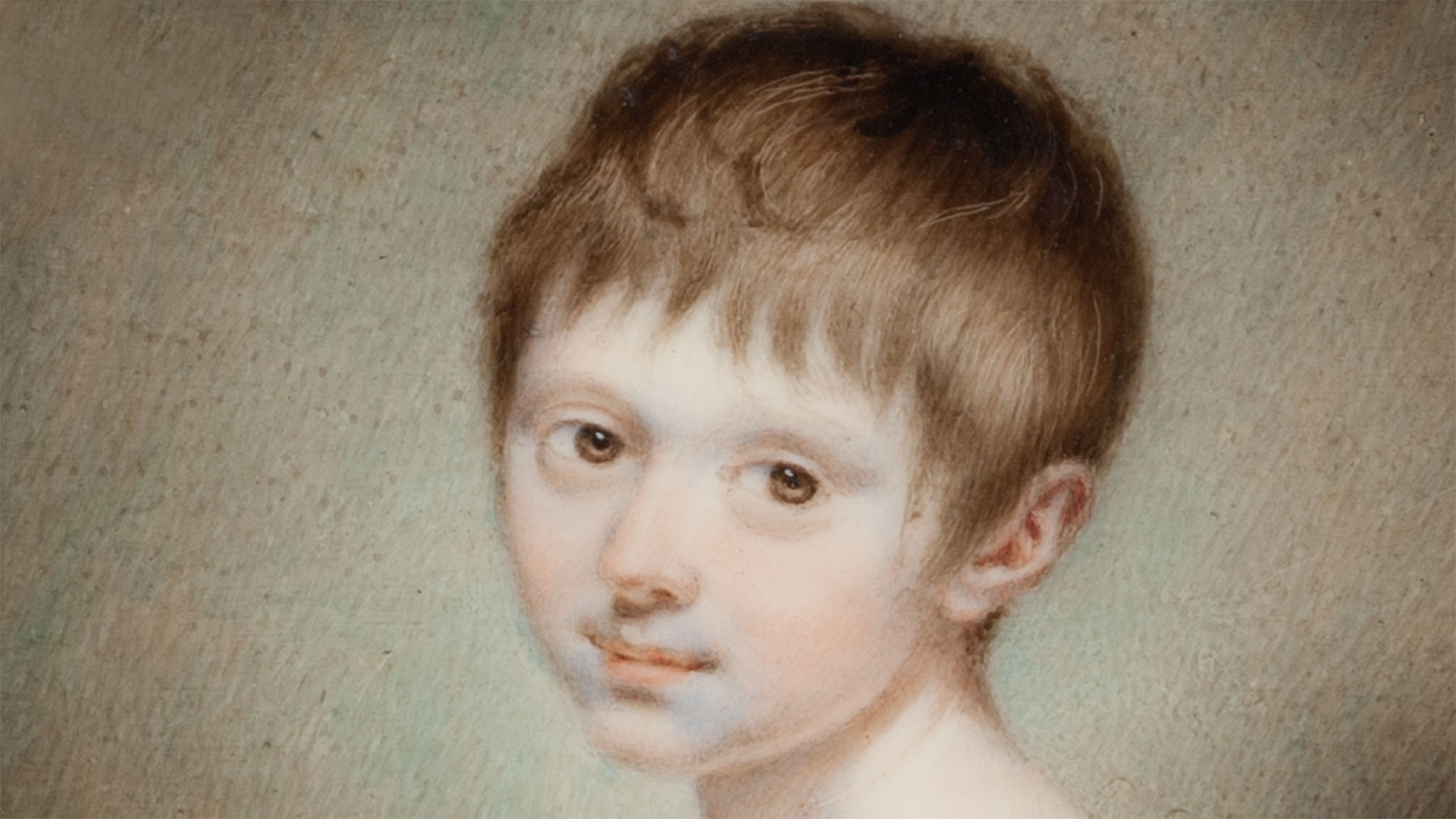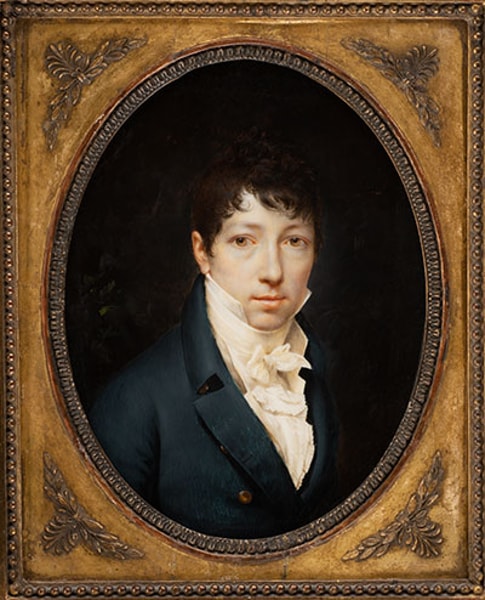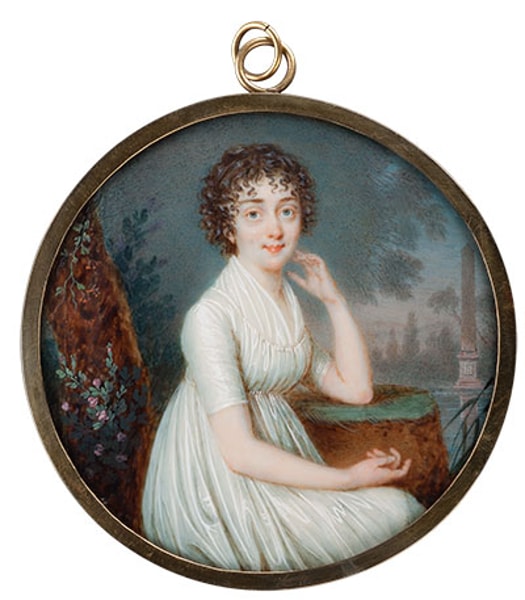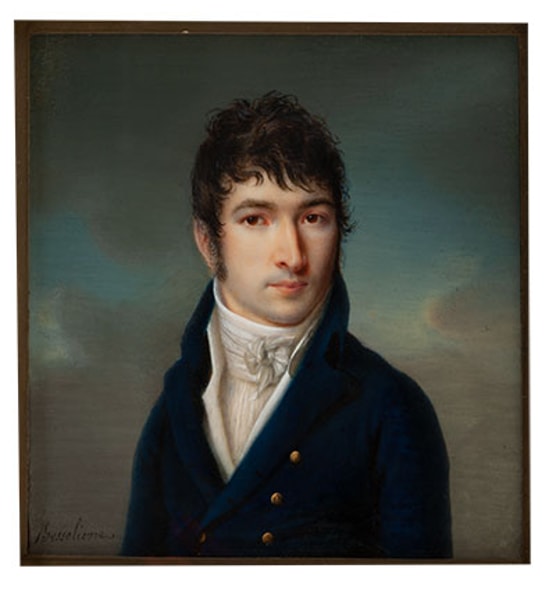
Napoleonic Period
Miniatures from the Time of Napoleon in the Tansey Collection
The portrait miniature from the time of the great military leader and emperor Napoleon Bonaparte spans the period from around 1795 to 1815 and falls in the middle of the “golden age” of miniature painting, which lasted from about 1780 to 1830.
”Modern” portraits
In the history of miniature painting, the Napoleonic era represents a transition from the carefully staged society portraits of absolutism to the bourgeois portraits of the Restoration and Biedermeier periods. The start of the French Revolution brought about an abrupt shift in style in France. The court portraits of the Ancien Régime, whose main purpose had been to demonstrate visually the membership of a certain estate, disappeared and were replaced by portraits which presented people increasingly as individuals. These new, more natural likenesses differed from the old-style portraits in their simpler compositions and poses, and also in the sitters’ hairstyles and clothing fashions. Powdered hair and wigs were already becoming rare in the late 1790s. Ladies’ clothing and hairstyles were inspired by ancient Greece. Plain, sometimes almost transparent, chemise dresses with low-cut necklines became especially popular; these were complemented with brightly coloured shawls. Women’s hair was worn in short curls around the forehead and temples. At the back and sides, long strands that were combed close to the head cascaded in apparent disorder onto the shoulders, if, that is, the hair was not pinned up on the back of the head and held in place with a comb. A style of short, comfortable curls was also common. Gentlemen’s fashions also became less showy. Coats were of a plain, dark colour. The only decorative elements were shiny metal buttons. Waistcoats were frequently pure white, but could also be made of coloured or patterned fabrics. Uniforms, however, were a different matter altogether, and their decorations knew virtually no bounds. Bright, contrasting colours were supplemented with impressive gold and silver embroidery, borders, cords, and various sparkling orders of merit, depending on rank and achievement.

Etienne Charles Le Guay: Gentleman in a Dark Blue Coat, c. 1815, Watercolour and gouache on ivory, inv. no.: 10423 read more...
At the turn of the 19th century, there were more miniaturists in Europe than ever before. They served a steadily growing number of clients. Not only rich or aristocratic men and women wanted to possess portraits of their nearest and dearest in this small format, but increasingly other sections of society did, too. Miniatures were no longer restricted to the wealthy elite, because these portraits were painted with the most varied levels of artistry, and their prices spanned a correspondingly broad spectrum. Those who wanted to have their portrait painted by a highly regarded painter had to pay a fee similar to that charged for a painting in oil on canvas – or possibly even more. People with less money at their disposal had to make do with artists who offered their services at what were sometimes knock-down prices.
Painting techniques and colours
During Napoleon’s time, miniatures were produced using various techniques. The most common one was watercolour applied to thin sheets of ivory, and so it comes as no surprise that most of the works presented here were painted using this method. The technique was very popular because the material (obtained from elephants’ tusks) was slightly transparent. Even before it was painted, ivory had an appearance similar to human skin and was therefore especially suitable for portraits.
Enamel miniatures were prized for their glowing colours and their durability. This technique was particularly difficult and called for skilled artists who also had the necessary materials and kilns. Enamel portraits had been popular since the time of Louis XIV, and the Napoleonic era can be seen as their final heyday. Fixé sous verre miniatures became available in the 1770s. This technique involved painting the image in oils on a piece of woven fabric. A cover glass was then glued directly onto the portrait, giving the colours great brilliance and depth (cf. inv. no. 11217, read more...). Some artists created their works not with paints and a brush, but in pencil. The hatching, which is of varying density and in some areas astoundingly wild, lends these portraits great vitality (cf. inv. no. 11425, read more.... The diverse range of techniques for creating miniatures is expanded by portraits in red chalk (cf. inv. no. 11468), The artists used only red-brown chalk which, coupled with the absence of dark colours, makes the picture appear soft and warm. While all these painting and drawing techniques had already existed previously, the portrait in watercolour on paper was invented during the French Empire. Fine sheets of paper were mounted on a panel of card or metal and covered with layers of translucent paint. The faces, finely rendered in great detail, formed a fascinating contrast to the clothing and background, which were painted freely with a broad brush. And finally, one special technique is found in the works by Jean-Jacques Karpff (cf. inv. no. 10400, read more.... This artist painted portraits on ivory, but exclusively in black ink. His virtuosity consists in the regular, parallel lines with which he shaded individual parts of the picture, thus creating a kind of visual vibration for the eye.

Jean-Baptiste Soyer: Dame in Park mit Obelisken, um 1800, Aquarell und Gouache auf Elfenbein, inv. no.: 10700 read more...
Unlike the theatrically exaggerated miniature portraits of absolutism, in Napoleon’s time, we see the first realistic likenesses of people who appear “modern”. The portrait of the young man by Claude Jean Besselièvre (inv. no. 11399, read more...). which was selected to illustrate the cover of the catalogue, is a good example. It shows a person without particular airs and graces and without gestures whose features the painter studied precisely and reproduced with differentiation. The picture contains no indication of a higher rank or special achievements. It concentrates on the individual and his affection for the recipient of the portrait.

Claude Jean Besselièvre: Herr in blauem Rock vor wolkigem Himmel, um 1810, Aquarell und Gouache auf Elfenbein, inv. no.: 10399 read more...